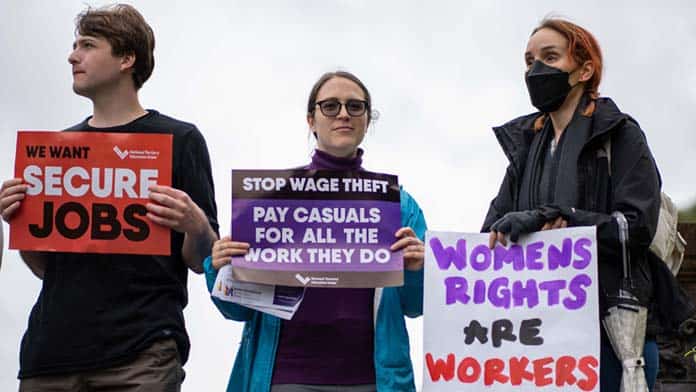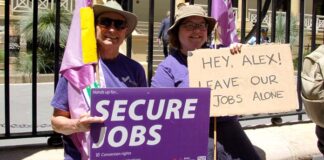Falling wages are a product of the way enterprise bargaining was designed to benefit employers and restrict the right to strike, writes James Supple
Labor’s Jobs Summit has been widely praised for bringing together unions, employers, academics and government to discuss the country’s long-term problems.
Modelled on Labor Prime Minister Bob Hawke’s economic summit, held shortly after he took power in 1983, the exercise was an effort to revive Hawke’s “consensus politics”.
The results this time were far less grand. But the whole approach of seeking consensus between unions and employers is a dead end for workers.
The earlier era of consensus politics under the Hawke and Keating Labor governments in the 1980s and 1990s delivered years of sacrifices and attacks on workers’ living standards—with a rotten legacy that continues today.
Workers are facing a cost of living crisis, with a likely wage cut this year of around 5 per cent after inflation. Average wage rises are at 2.6 per cent and inflation is set to rise to almost 8 per cent by the end of the year.
This comes after a decade of stagnant wages. Yet business has been doing very well indeed. Total profits rose 55 per cent in the last year alone, a CommSec review of company reports found. The profit share of the economy has surged to its highest point in the post-war period, with the wages share its lowest on record.
Bosses are complaining of labour shortages across the economy. This would normally increase workers’ bargaining power and allow unions to push up wages. But that hasn’t happened.
Why? According to ACTU’s Sally McManus, “The main reason why wages have collapsed is because collective bargaining has collapsed.”
There has been a drastic decline in the number of workers covered by an enterprise bargaining agreement, with the number of agreements dropping from 23,500 to 10,000 since 2013.
Just 11 per cent of workers in the private sector are now covered by enterprise bargaining deals.
The ACTU is pushing industry-wide bargaining as the solution. But what’s proposed is only a modest change to the system. The problems with enterprise bargaining run much deeper.
Enterprise bargaining was introduced as the end point of the neoliberal restructuring of industrial relations imposed under the Hawke and Keating Labor governments.
When the Labor government took office in 1983, it set out to cut wages and restore corporate profits. This, they claimed, would eventually benefit workers through creating jobs and allowing companies to increase pay.
Union leaders bought into the idea of consensus between the government, employers and the working class.
This resulted in the Prices and Incomes Accords, designed to halt strike action and impose wage restraint in exchange for increases in the “social wage”, such as the introduction of Medicare and higher welfare payments.
Wages increases were set through a series of National Wage Cases, based on the Accord negotiations. But over time workers took serious wage cuts, with the social wage never compensating for what they lost.
Yet profits boomed by 10 per cent a year between 1985 and 1990. The government also slashed the rate of corporate tax from 49 to 33 per cent. Consensus delivered big gains for business profits but endless sacrifice for workers.
Union strength also began to decline, with strikes and rank-and-file organisation no longer needed to win pay rises, which were simply negotiated from the top down. Trade union membership began to fall.
There was a further shift from 1991. A national wage increase was delayed and Awards declared only a “safety net”. Future wage rises would depend on what workers could negotiate at a company level through enterprise bargaining.
The new system also made wage rises dependent on delivering increased productivity, forcing workers to “trade off” workplace rights and conditions.
Keating made this explicit, saying he wanted to allow companies to get “the great productivity advances available from changing workplace arrangements and conditions”.
Many early agreements saw workers trade away penalty rates or accept hundreds of job cuts. Companies extended the span of “ordinary hours” when penalty rates would no longer apply.
In 1994 the Commonwealth Bank and Advance Bank were allowed to abolish penalty rates for work on evenings and weekends. Email Appliance factories began paying ordinary rates for any work between 6am and 6pm.
Wage rises came at the cost of working harder and longer.
About 60 per cent reported an increase in work effort, and between 50 and 60 per cent said work had become more stressful, according to government surveys collected in the first two years of the new system.
Enterprise bargaining saw unions accept the role of delivering what business wanted through accepting productivity trade-offs in the same spirit of class collaboration as the Accords.
Workers hated it. By the time of the 1996 election Labor Senator Nick Sherry recalled that talking about “productivity” and “efficiency” around workers was “a good way to end your life”.
The result was that union membership plummeted further, dropping from 40 per cent in 1992 just after enterprise bargaining began to 31 per cent just four years later when Labor lost office. Today this is down to just 14 per cent.
Today’s failure of enterprise bargaining to deliver wage rises that keep pace with the cost of living is exactly what the system was designed to deliver. It ended the principle that wages rises should be based on the cost of living.
As then Prime Minister Paul Keating put it in 1993, the idea was to keep wage costs down through ensuring “unit labour costs will remain competitive”.
Restricting strike action
Enterprise bargaining has worked to drastically weaken union power.
It has split up workers, with areas where there is strong union membership and organisation able to win some improvements to wages and conditions, while others are left behind. This has taken place both between industries, for instance in high-paid construction versus low-waged aged care, as well as within industries, so that small non-union construction jobs often have wages drastically below the big sites.
It has gone hand in hand with laws against strikes and industrial action that restrict workers from using their most powerful weapon against the bosses. These are further evidence of how much the system was intended to benefit the employers.
Enterprise bargaining was entrenched with Keating’s introduction of the Industrial Relations Reform Act in 1994.
This limits lawful strike action to the narrow “bargaining period” when a new agreement is being negotiated every three or four years. After a new enterprise agreement is finalised, bosses can sack hundreds of workers or introduce other workplace changes but unions are banned from using industrial action to fight it.
Pay rises set in new agreements cannot be re-negotiated for several years, locking in pay cuts when there is a sudden surge in the cost of living like that over the last year.
Even legal “authorised” industrial action has all sort of restrictions. Unions must hold a drawn-out postal ballot of members and then notify the employer before they call action.
The Fair Work Commission can also order a halt to industrial action deemed to “damage the economy” or “endanger the welfare” of the population.
This saw a 24-hour rail strike banned in 2018 on the grounds it would harm the NSW economy. In other words, the strike would have been too successful.
Efforts at “pattern bargaining”, where unions demand the same claims at different companies across the same industry, are also banned.
In 2018 crane drivers in NSW at WGC Cranes and Boom Logistics were banned from striking for three months after their union, the CFMEU, presented bosses with a template agreement designed to establish common conditions across the crane industry.
Right to strike
But it is possible to defy the law and wage a serious fight against the bosses. The crane drivers eventually won big pay rises through illegal hard pickets and other unlawful action.
CFMEU members joined repeated stopwork rallies in 2017 and 2018 outside official bargaining periods, defying letters from their employers threatening individual $34,000 fines.
“We’re all breaking the law here at the moment,” Victorian construction union secretary John Setka told a crowd of 10,000 workers at a Melbourne stopwork in 2017.
In 2012 Victorian nurses defeated the state Liberal government after an eight-month industrial campaign. They defied Fair Work orders banning strike action and threats of $6600 fines against individual nurses and up to $33,000 against the union.
Teachers and nurses in NSW have also repeatedly defied strike bans ordered this year by the state Industrial Relations Commission, where the penalties are lower.
Even limited defiance can win gains when backed by a commitment to serious strike action.
United Workers Union members at Country Road in Melbourne won pay rises and new permanent positions late last year after 12 days on strike. An unlawful hard picket was lifted after the first day following a court injunction.
In 1969 unions defeated previous anti-strike laws, the penal powers, following a concerted campaign of refusing to pay the fines. This forced a confrontation where union leader Clarrie O’Shea was jailed before a nationwide general strike won his freedom.
A similar campaign of defiance is needed today to break the restrictions on the right to strike.
The unions have been seriously weakened since the 1980s. But too many union leaders have responded by accepting the limitations of enterprise bargaining and ended up collaborating with employers over cuts to workers’ conditions.
Seeking consensus with the bosses or the Labor government won’t deliver the change that’s needed. Workers and our unions are going to have to fight for it themselves.






